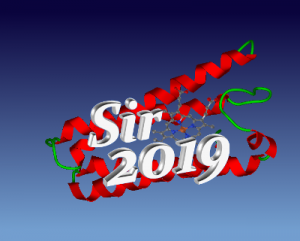
Sir2019, the evolution of Sir2014, is the latest product of the Sir family.
The SIR (SEMI-INVARIANTS REPRESENTATION) package was originally developed for ab initio crystal structures solution by Direct Methods (DM). The REPRESENTATION THEORY, proposed by Giacovazzo (1977, 1980) allowed the derivation of powerful methods for estimating structure invariants (s.i.) and structure seminvariants (s.s.). The mathematical approach makes full use of the space group symmetry. SIR uses symmetry in a quite general way allowing the estimation and use of s.i. and s.s. in all the space groups.
Data
Data can be collected with X-Ray, electron or neutron sources. There is no limit to the number of reflections and to the number of atoms in the asymmetric unit. The maximum value allowed for |h|, |k|, |l| is 512. The maximum number of different atomic species is 18.
Tasks
Sir2019 is designed for the automatic ab initio and non ab initio crystal structure solution of small, medium and macromolecules according to the following scheme:
Ab initio phasing approaches:
-
-
- Modern Direct Methods (MDM)
-
- Standard Direct Methods (SDM)
-
- Vive la Difference (VLD)
- Patterson techniques
-
Default strategies
MDM is the default choice for small (up to 80 non-hydrogen atoms in asymmetric unit ) and medium sized structures (up to 300 non-hydrogen atoms in asymmetric unit).
SDM is the default choice for electron diffraction data.
For proteins, if heavy atoms are contained in the unit cell, the default choice is the Patterson approach. MDM is the suggested second choice.
Non ab initio phasing approach:
-
-
-
- Simulated Annealing (for s/m molecules)
- Simulated Annealing (for s/m molecules)
- Molecular Replacement
- SAD/MAD
-
-
Simulated Annealing is applied when some geometrical information about the target molecule is a priori available.
Molecular Replacement is applied when a model structure is available: the relative routines perform the rotation and translation steps, automatically followed by phase extension and refinement.
In SAD/MAD cases, the anomalous scatterer substructure is found and refined first. Then such information is actively and automatically used to phase the protein and for final phase extension and refinement.
Automatism
The program has been designed to:
-
- require a minimal input information;
-
- work automatically;
- reduce the user intervention and facilitate the interaction by means of a friendly graphic interface.
Expert crystallographers have a wide range of options to solve their crystal structures.
New features have been added to Sir2019 with respect to the previous version (Sir2014). From the practical point of view the user may exploit:
-
- a new Molecular Replacement pipeline (from MR application to the automatic model building);
- a SAD/MAD pipeline (from SAD/MAD application to the automatic model building);
- an ab initio Patterson pipeline (from the application of Patterson techniques to automatic model building)
The three pipelines are available because of recent advances in phase extension and refinement (see the description of SYNERGY, in Phase Module) and in automatic model building (see the description of CAB in Phase Module)
It is not only a visualizer for models and maps: it can also be a useful tool to edit the model. It can be used as an external program (started from its icon or from teminal) or as an alternative to the classical visualization of the model by Sir2019.
The program uses some CCP4 (Collaborative Computer Project 4, Daresbury Laboratory, UK) libraries in accordance with the CCP4 License Agreement (clause 2.1.2) and it is linked to external programs to face with protein structure solution (Refmac, Buccaneer, Nautilus, ARP/wARP, Phenix). The program uses FFTw (Frigo & Johnson, 2005) and GTK libraries which are distributed under the GPL (GNU General Public License).
The program is available for Microsoft Windows, Linux and Mac platforms (see the Installing the program section).
Authors:
M.C. Burla(1,2), R. Caliandro(1), B. Carrozzini(1), G.L. Cascarano(1), C. Cuocci(1), C. Giacovazzo(1), M. Mallamo, A. Mazzone(1), G. Polidori(1), D. Siliqi(1)
(1) Istituto di Cristallografia, CNR, Bari, Italy.
(2) Dipartimento di Fisica e Geologia, Università di Perugia, Perugia, Italy.
Support:
E-mail: sirmail@ic.cnr.it
References:
M.C. Burla, R. Caliandro, B. Carrozzini, G. L. Cascarano, C. Cuocci, C. Giacovazzo, M. Mallamo, A. Mazzone and G. Polidori
“Crystal structure determination and refinement via SIR2014”,
J. Appl. Cryst. (2015). 48, 306–309